Family : Haemulidae

Text © Giuseppe Mazza

English translation by Mario Beltramini
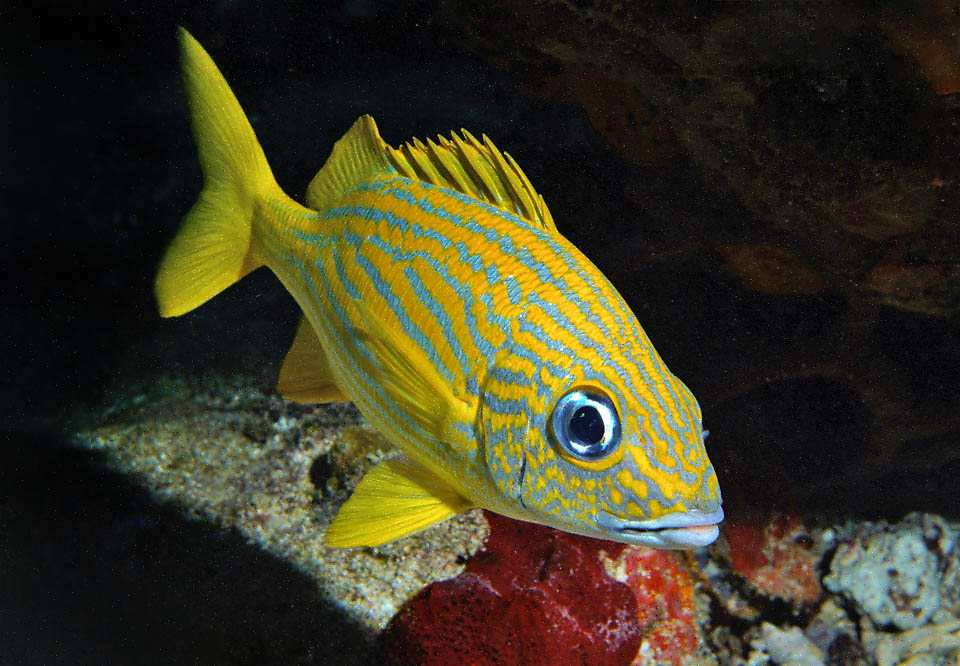
Haemulon flavolineatum is at once recognized by its 3 yellow orange horizontal stripes towards the back, that cross under the lateral line with other diagonal ones © Pauline Walsh Jacobson
The French grunt, Haemulon flavolineatum (Desmarest, 1823), belongs to the class of the Actinopterygii, the ray-finned fishes, to the order of the Perciformes and to the family of the Haemulidae, mainly present in marine and brackish waters with 23 genera and 135 species.
They are fishes that rarely exceed 60 cm in length and resemble at first sight due to their appearance the Sparidae or the Sciaenidae.
The genus Haemulon was born from the Greek “αἷμα” (emo), blood and “οὖλον” (oulon), gingiva, with reference to the bright red colour of the inside of the mouth, whilst the specific term flavolineatum adds, in Latin, that it’s a yellow-striped fish.
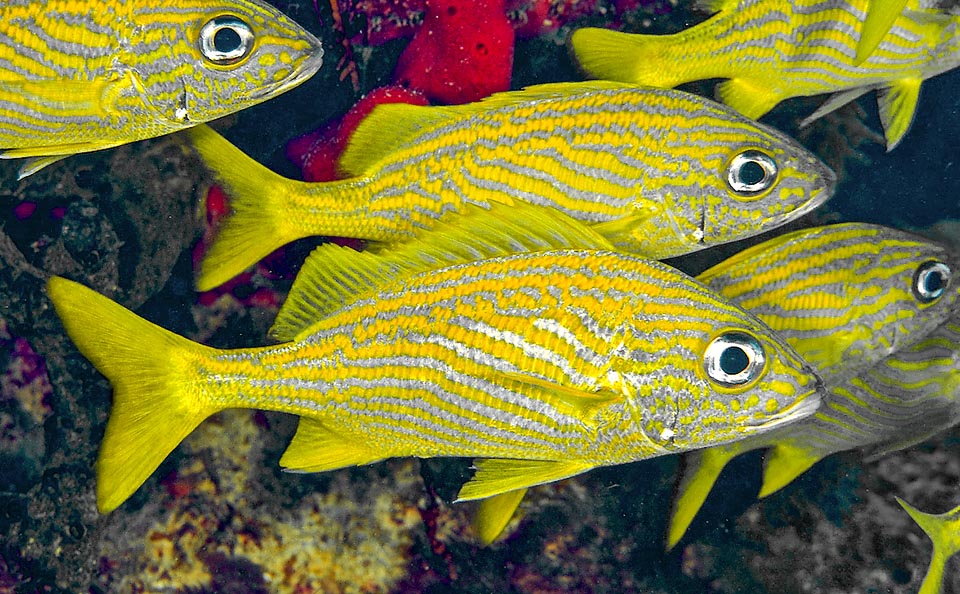
It’s a Caribbean fish of the family of the Haemulidae that can attain the length of 30 cm © Allison & Carlos Estape.
The vulgar term of Grunt, reminds instead the sound, compared to a grunt, that the haemulids emit, using the swim bladder as sounding box while they gnash their numerous pharyngeal teeth, during the mating, to surprise the predators or when they are grabbed by the fishermen.
English do call it “French grunt” as described by the French physician and zoologist Anselme Gaëtan Desmarest (1784-1838) or “Banana grunt” due to the dominant yellow colour of the livery recalling the colour of bananas. Conversely, the French prefer on their part to call it “Gorette jaune”, adding the prevailing colour of the fish to the common name of “Gorette” used in the French Antilles for all Haemulidae.
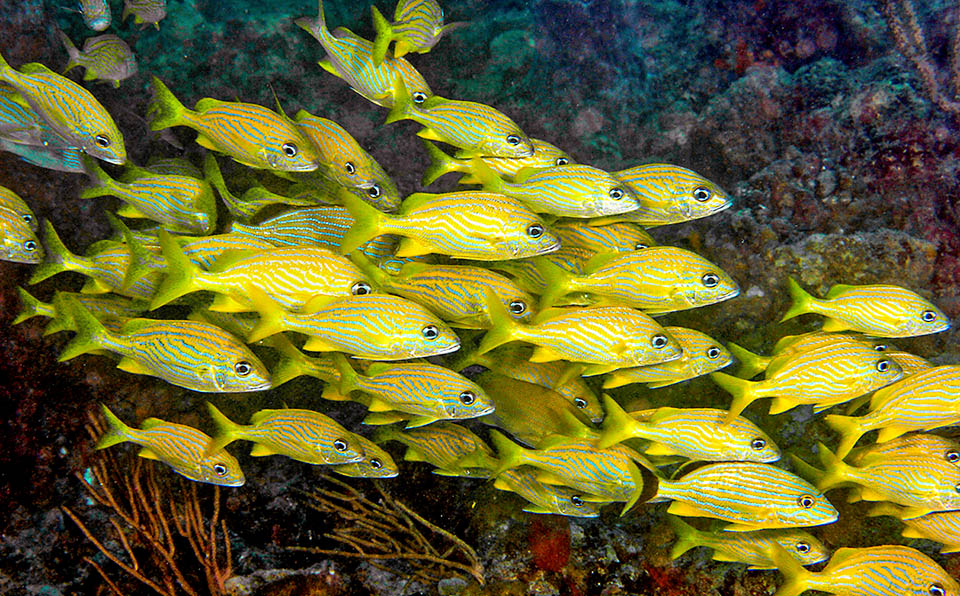
It often lives mixed with other haemulids like Haemulon sciurus, well visible on right below with the base of the caudal fin and of the dorsal blackish © Kevin Bryant
Zoogeography
Haemulon flavolineatum is a very common species in the tropical waters of western Atlantic, from Bermudas and South Carolina and the Gulf of Mexico up to the coasts of Trinidad and Tobago and Venezuela.
Ecology-Habitat
It lives among the madreporic formations especially in shallow waters, never going down to more than 60 m of depth.
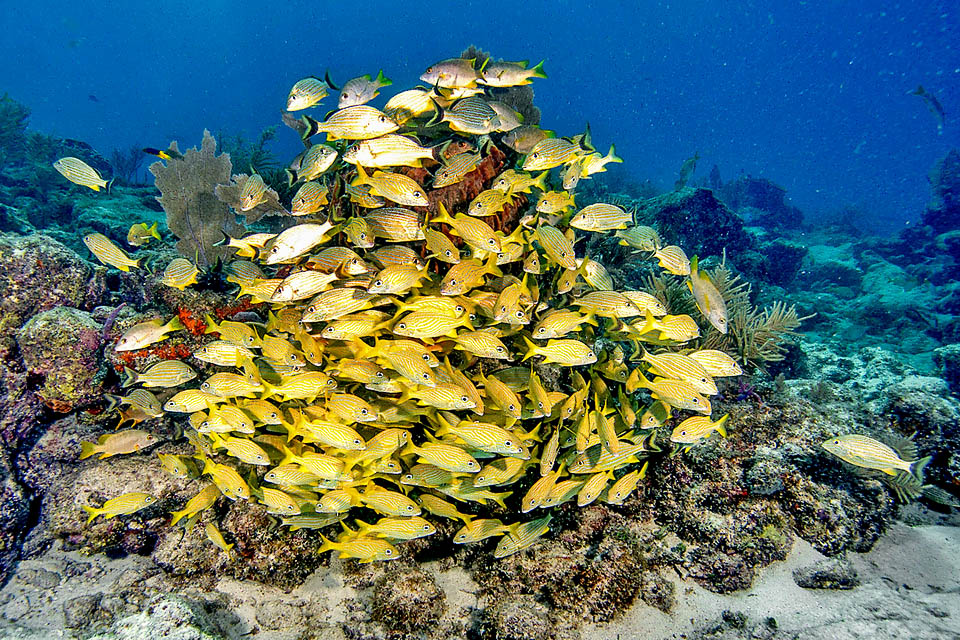
During the day these often gather motionless around a madrepore confusing with this one in a sort of “social camouflaging” © Allison & Carlos Estape
During the day, in order to escape the gaze of the predators, it does exactly the opposite of the other fishes. Instead of hiding into a den, it gathers around a giant sponge or a well exposed madrepore forming a motionless school that, seen from far away, gets confused with this one within the colourful world of the corals.
Actually, a “social mimicry” and also the possible defense occurs in groups with squads that, alternating, do bite the tail of the importunate, mainly groupers, deafening it with grunts. And while this turns around to understand who did it, others still nibble it from the back, confusing its ideas until when, annoyed, the predator gets away.
By evening, the school breaks up and everyone goes its own way looking for food.
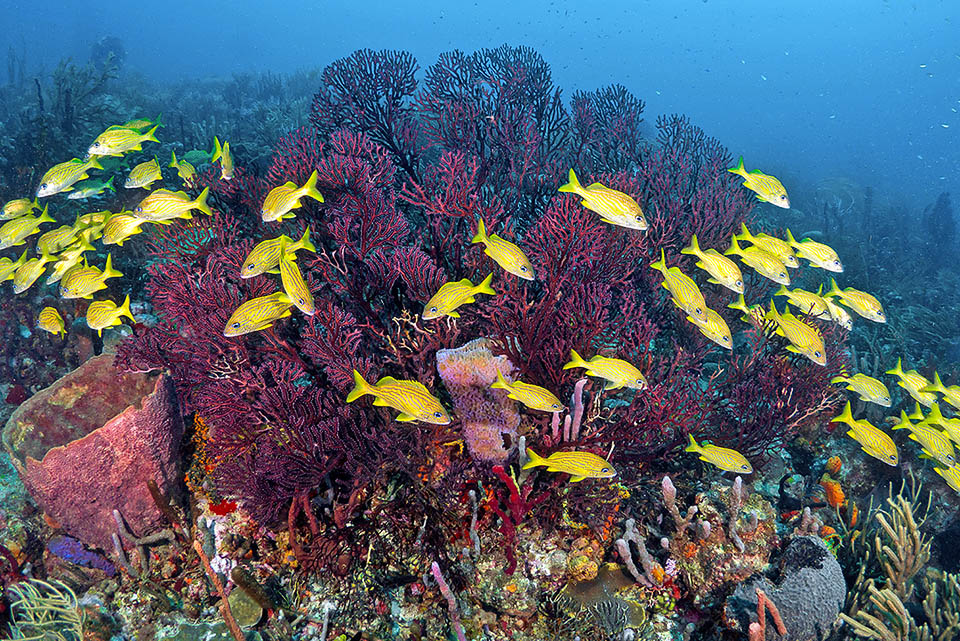
Then, towards evening, the group breaks up and each goes its own way looking for food © Brian Cole
Conversely, the juveniles grow up mainly hidden into the mangroves formations or among the leaves of the submerged prairies of phanerogams feeding, contrariwise, during the day.
Morphophysiology
Haemulon flavolineatum can attain a length of 30 cm even if the size of the catch generally is of 17 cm. The body, slightly compressed laterally, is characterized by yellow stripes on a silvery white background with bluish reflections depending on the incidence of light. Over the lateral line there are three orange yellow horizontal stripes that cross the body from the head to the tail, whilst under the stripes are arranged diagonally with scales clearly larger than the upper ones.
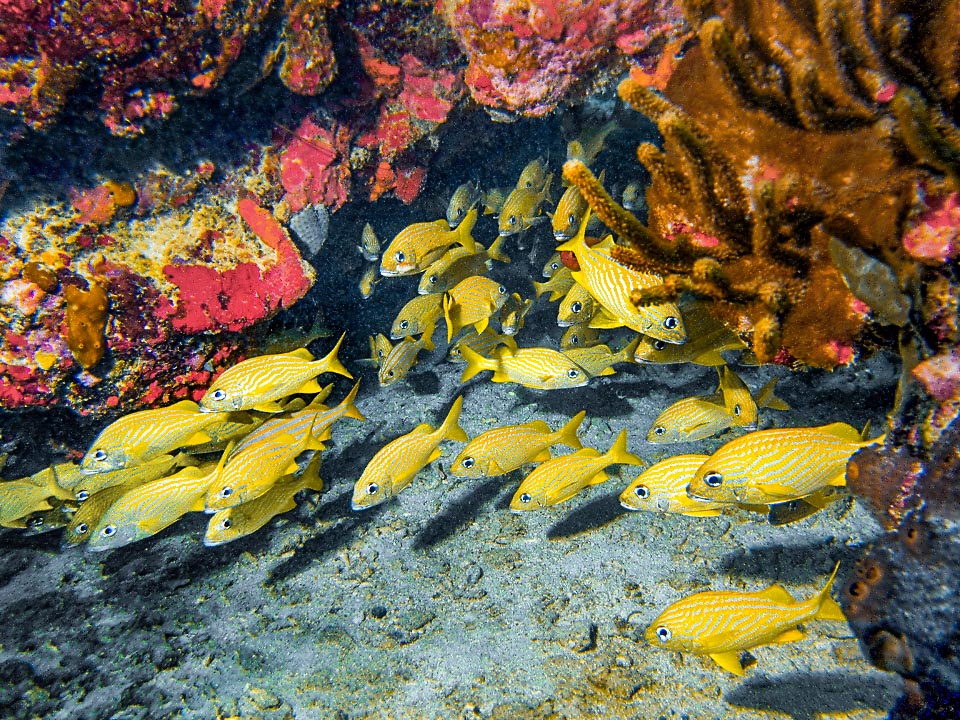
They look on the seabeds for small benthic crustaceans, mainly crabs, and polychaetous worms © Pauline Walsh Jacobson
Under the eyes, on the head, we note some yellow spots and the inside of the mouth is conspicuously covered in red. They do not have canine teeth but small and thick conical teeth called cardiform, arranged in bands.
All fins are yellow. The dorsal has 12 spiny rays and 14-15 soft, the anal 3 spines and 8 unarmed rays. The pectoral ones have 16-17 soft rays and the pelvic fins do not display spines. The caudal is furcate.
In the juvenile livery we note two long dark longitudinal stripes ending on the caudal peduncle. The lower one crosses the eye masking it and among these one very short and thin stripe touches the upper part of the eye. Under the lateral line, like in adults, the scales are arranged diagonally.
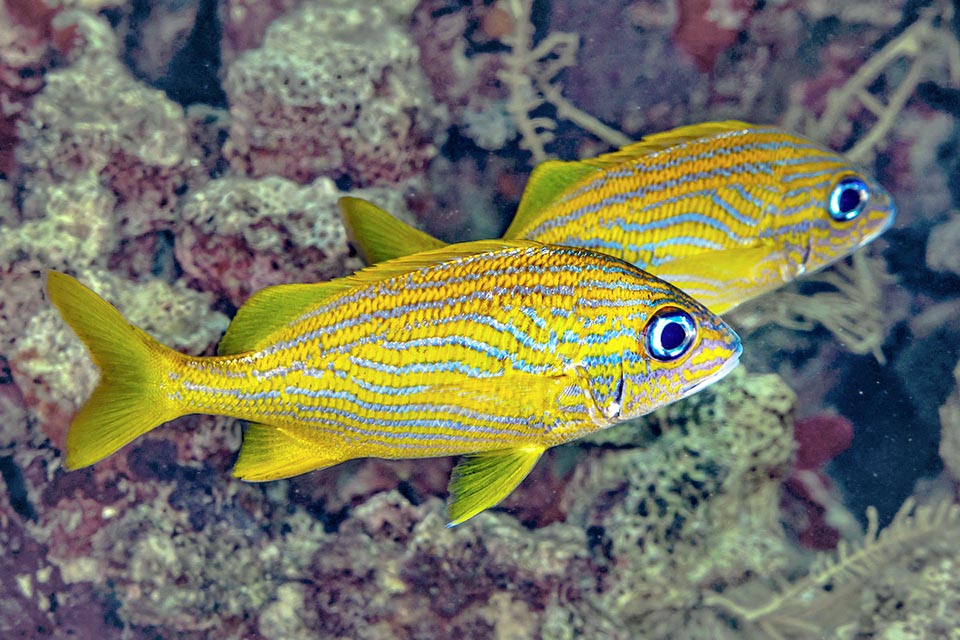
The reproduction of these grunting fishes does not happen in schools but in couples © Allison & Carlos Estape
At the end of the caudal peduncle a showy black spot simulates, as often occurs in the world of fishes, a false eye to deceive the predators by directing them towards the more elusive and less vital part of the body.
Ethology-Reproductive Biology
In the daytime camouflage gatherings Haemulon flavolineatum is often found aggregated with other haemulids like the Brachygenys chrysargyreum, with the cylindrical horizontally yellow striped body, Haemulon sciurus, also with thinner horizontal stripes but with the base of the caudal fin and of the dorsal of blackish colour, or Haemulon aurolineatum with less evident yellow stripes, but those on the eye and often a black spot on the caudal peduncle.
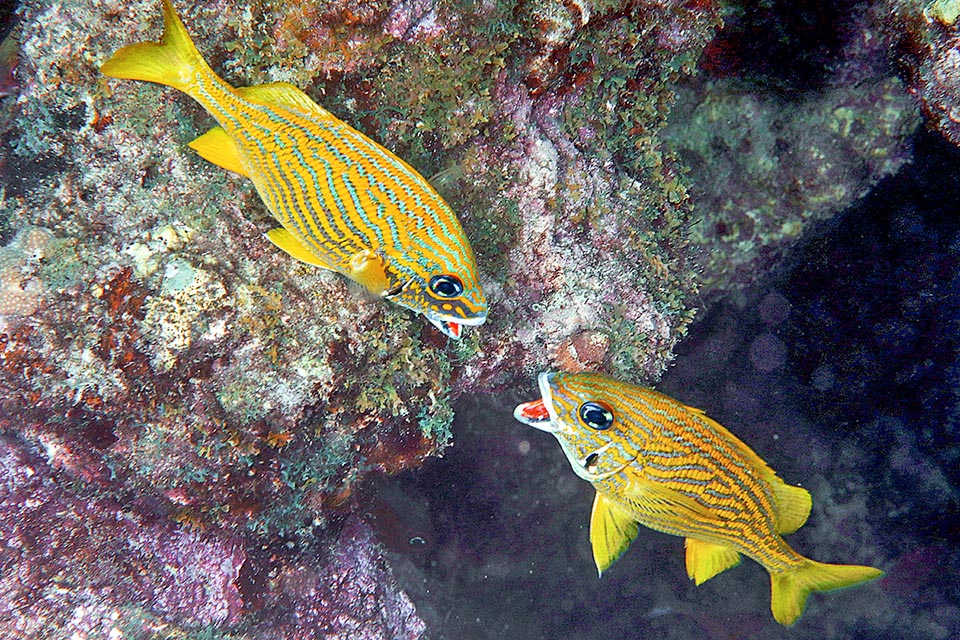
It may happen that two males choose the same female, but they do not fight by ferociously biting. They are content to compare the size of the mouth © Kevin Bryant
Haemulon flavolineatum feeds on small benthic crustaceans, mainly crabs, and polychaetous worms.
Among its predators stand out the Nassau grouper (Epinephelus striatus), the Caribbean Trumpetfish (Aulostomus maculatus), the Sand diver like Synodus intermedius and the ill-famed Pterois volitans incautiously introduced in the Caribbean.
Haemulon flavolineatum attains sexual maturity when about 12-15 cm of size and usually reproduces in spring-summer but even during the whole year in the warmer climates. Mating does not happen as we might think in groups, but with a male and a female that by the sunset go up releasing the gametes into the overlying water column.
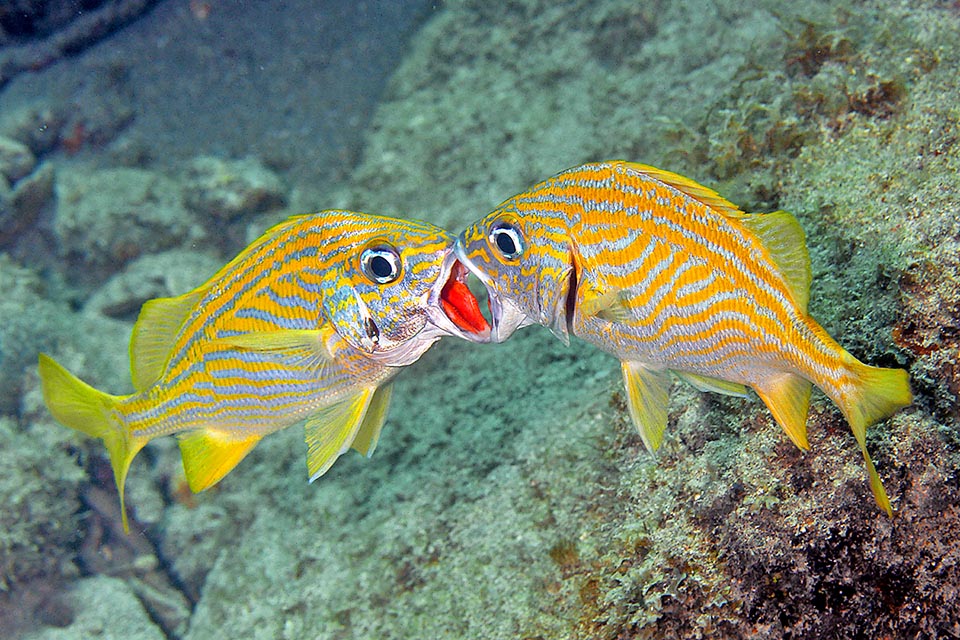
Whoever has the biggest one wins. The fecundated floating eggs are entrusted to the sea and the larvae reach the bottoms after about two weeks © Kevin Bryant
One unique female can lay, at each event, from 6.000 to 16.000 floating eggs that are entrusted to the currents.
Also the larvae are pelagic, but after 2 weeks, they reach the seabeds growing in the submerged prairies of phanerogams or among the roots of the mangroves with a lifespan of 8 years.
Despite the relatively modest size, Haemulon flavolineatum is a widely caught fish and consumed in the Caribbean even if there is a light risk of ciguatera poisoning when they have preyed on animals storing in their tissues the toxin produced by the dinoflagellate Gambierdiscus toxicus.
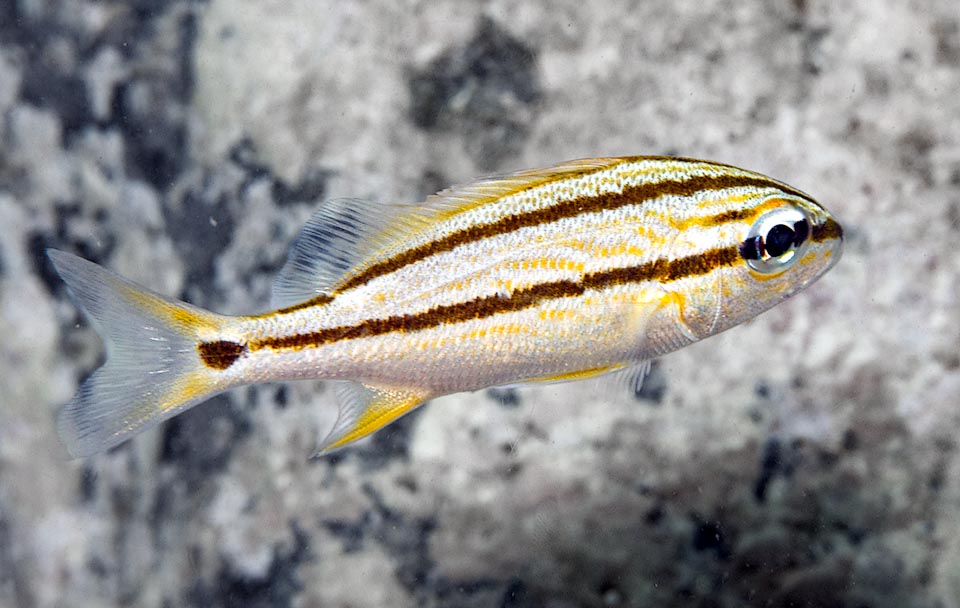
The juvenile livery with two dark horizontal stripes is quite different from the adult one and there is a black spot simulating an eye at the base of the caudal fin © Allison & Carlos Estape
To overcome this inconvenience and taken into account its great prolificacy, it is nowadays reproduced in aquaculture, and despite the intense fishing pressure, the populations do not presently appear to be decreasing.
The resilience of the species is mediocre, with the populations that may theoretically double their members in 1,4-4,4 years. The fishing vulnerability, moderate, marks only 32 on a scale of 100 and Haemulon flavolineatum consequently appears as “LC, Least Concern”, that is at minimal risk, in the IUCN Red List of the endangered species.
Synonyms
Diabasis flavolineatus Desmarest, 1823.
→ For general information about FISH please click here.
→ For general information about BONY FISH please click here
→ For general information about CARTILAGINOUS FISH please click here.
→ To appreciate the BIODIVERSITY of BONY FISH please click here.
→ To appreciate the BIODIVERSITY of CARTILAGINOUS FISH please click here.
